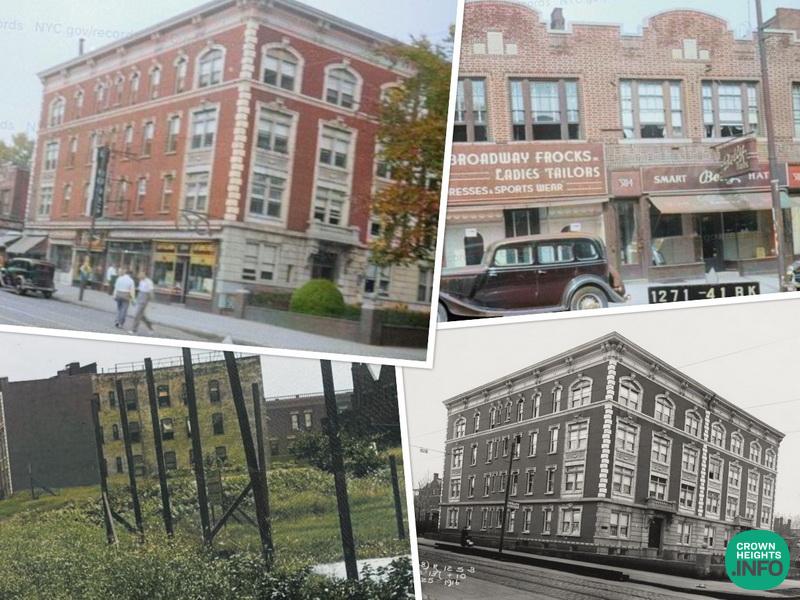
Crown Heights History: The Vanderbilt Farm and 788 Eastern Parkway
by Crown Heights Historian Shmully Blesofsky. His Instagram account History of Crown Heights.
784-788 Eastern Parkway, 1916.
Towards the end of the 19th century, Crown Heights marked the edge of the City of Brooklyn. To the south of Empire Blvd (then Malbone St.) was part of the municipality of the Town of Flatbush. At that point, Crown Heights consisted mostly of farmland plots, typically about 200 by 1800 feet.
A portion of a map of Crown Heights lots in 1890. Then known as Crow Hill.
Kingston (then Hudson) and Eastern Parkway.
The lots upon which 784 and 788 Eastern Parkway now stand were owned by Jeremiah Vanderbilt Spader, a well-known resident of Brooklyn. He owneda lumber business and also served as the Director of the Brooklyn Fire Insurance Company and had a large estate in Clinton Hill. He was a 5th cousin of Cornelius Vanderbilt, the well-known railroad and shipping magnate.
In 1898, the Eastern Parkway Company led by Frederick Rowe, a real-estate developer, and later a congressman, purchased land surrounding the Vanderbilt’s farms with the intent to develop a planned neighborhood.
A 1906 Map of the Eastern Parkway Company Purchase of Crown Heights.
In 1902, Jane E. Hadden purchased the lot for $32,000. In 1913, M. F. Gleason, a real estate company, constructed the buildings at 784 and 788 Eastern Parkway and called them “The Parkway”. They were advertised as boasting “elegant suits of 7 rooms in the finest location in Brooklyn”.
Announcement of the sale of the JV Spader Farm to Jane E Hadden. Standard Union, 1902.
788 Eastern Parkway newspaper advertisement. Brooklyn Daily Eagle, 1912.
784-788 Eastern Parkway in 1916. Approximately three years after the buildings were completed.
Here you can see the last house on Union Street and the empty lot on Kingston Ave in 1916 upon which the 304-308 Kingston Ave structure was built (the Viber Shul and Mikvah). There was a trolly stop on the corner as well.
In 1912, M. F. Gleason also constructed similar buildings at 792 Eastern Parkway called “Parkway Court” which was later torn down to build the Jewish Children’s Museum and “Parkway View” at 900 Eastern Parkway (near Albany).
900 Eastern Parkway, one of three identical projects built by M. F Gleason in 1912.
900 Eastern Parkway, one of three identical projects built by M. F Gleason in 1912.
792 Eastern Parkway across of Kingston Avenue. One of three identical projects built by M. F Gleason in 1912.
Another angle from 1916. Only 788 was built.
Another angle from 1916. Only 788 was built.
In this 1916 picture The back of 788 Eastern Parkway can be seen to the left. On the right is the last house on (1457) Union Street, and in the middle is a house across the street on the corner that was torn down to make room for the Farban (now the Kollel).
On the far left was the house that was torn down in the late 1920s to make room for a bowling alley, stores, and an event space which was purchased in the 1960s by Rabbi Leibel Alevsky what was then known as the Farban, today it houses the Kollel. Picture is from a 1923 lawsuit.
1910 New York Times feature showing Union Street and Kingston Avenue before the Mikveh/Viber shul buildings were constructed.
302-308 Kingston Ave (also known as Union Mikvah and the Kingston Viber Shul) was built in 1922 by the Kingston Avenue Union Street Corporation.
A statement in the paper declaring the sale of 302- 308 Kingston Avenue.
1923 newspaper announcements of new stores put in under 788 Eastern Parkway or what then became 294 Kingston Ave. “Fine opportunity for progressive merchants.”
In 1923, Kingston Ave was being used as a commercial thoroughfare. There were but a few stores but it was mostly residential. Many buildings were constructed without commercial spaces and were added later to accommodate the community’s growing needs.
788 Eastern Parkway, 1940 (colorized). Note that there are stores on the Kingston side of the building and that Kingston was then a two-way street.
Kingston Ave Bet. EP and Union, 1940.
Note Hortons Ice Cream Shop the little store in between the two buildings. It was first mentioned in the newspaper in 1926, and we assume it was initially an empty lot with only a small structure erected. Being only one floor there wasn’t a strong basement foundation dug in below which allowed for easier digging 100 years later.
304 Kingston Ave Bet. EP and Union, 1940.
304 Kingston Ave Bet. EP and Union, 1940.
306 Kingston Ave Bet. EP and Union, 1940.
In the mid 1960’s 788 and 784 were purchased by Aaron Klein who gifted them to the Rebbe. The first extension was completed in late 1968, and a second extension in 1978 when the shul was extended to Kingston Avenue.
The 1973 construction was overseen by the then gabbai and established community member Reb Zalman Blesofsky and assisted by his son, the well-known and beloved Bal Menagen Aaron Blesofsky, Shyeichyeh. The stores either left the neighborhood or moved across the street to the Farban.















